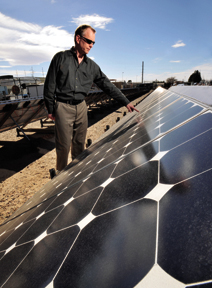
Sandia is part of a DOE-led effort to move the 50th state away from its reliance on fossil fuels and into a new era built around green technologies.
Recently DOE and the state of Hawaii signed an agreement to implement clean energy technologies that will increase energy efficiency and maximize use of the state’s vast and abundant renewable resources.
The agreement establishes the Hawaii Clean Energy Initiative (HCEI), a long-term partnership designed to transform Hawaii’s energy system to one that utilizes renewable energy and energy-efficient technologies for a significant portion of its energy needs.
The aim of HCEI is to put Hawaii on a path to supply 70 percent of its energy needs using clean energy by 2030, which could reduce Hawaii’s current crude oil consumption by 72 percent. This type of clean energy transformation will continue to help sharply reduce greenhouse gas emissions.
Juan Torres (6332), Sandia lead for the initiative, says Sandia’s role in HCEI is to provide technical advisement, analysis, and engineering support for clean energy projects, policy, and regulations.
“Sandia is serving as a bridge to help bring clean energy solutions to Hawaii,” Juan says. “We are defining projects to make immediate impacts.”
In the nearterm, Sandia will be leading a project to help the island of Lanai achieve its goal of using 100 percent renewables for all of its energy needs, Juan says.
Sandia also plans to help the island of Kauai incorporate renewables as part of its generation portfolio. In addition, Sandia will assist privatized military housing communities with the implementation of renewables to reduce their energy costs.
Hawaii currently meets about 90 percent of its energy needs through imported oil refined into gasoline for transportation and diesel for electricity. Because of its location, Hawaii’s gasoline and electricity prices are typically the highest in the nation, says Juan.
Alexander Karsner, DOE assistant secretary for energy efficiency and renewable energy, and Kevin Kolevar, DOE assistant secretary for the Office of Electricity Delivery and Energy Reliability, have committed DOE technical and policy expertise and capabilities to help demonstrate reliable, affordable, and clean energy technologies in Hawaii.
“With an abundance of natural resources and environmental treasures, Hawaii is the ideal location to showcase the broad benefits of renewable energy at work on an unprecedented scale,” says Karsner. “Hawaii’s success will serve as an integrated model and demonstration test bed for the United States and other island communities globally, many of which are just beginning the transition to a clean energy economy.”
DOE will work with Hawaii to further the potential of its natural resources, including wind, sun, and bioenergy resources. DOE will engage experts in clean energy technology development to help Hawaii to launch several projects with public and private-sector partners that target early opportunities and critical needs for Hawaii’s transition to a clean energy economy. Projects include designing cost-effective approaches for the exclusive use of renewable energy on smaller islands and designing systems to improve stability of electric grids operating with variable generating sources, such as wind power plants on the islands of Hawaii and Maui.
Other DOE-led projects that are part of this agreement include expanding Hawaii’s capability to use locally grown crops and byproducts for producing fuel and electricity and assisting in the development of comprehensive energy regulatory and policy frameworks for promoting clean energy technology use.